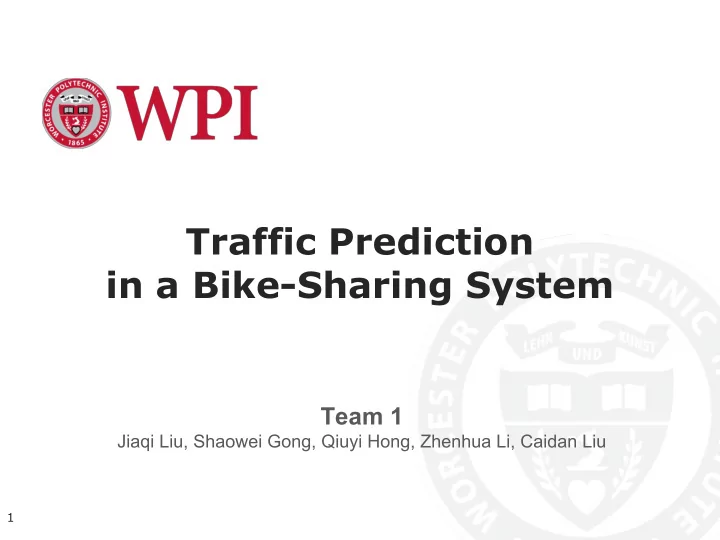

Traffic Prediction in a Bike-Sharing System Team 1 Jiaqi Liu, Shaowei Gong, Qiuyi Hong, Zhenhua Li, Caidan Liu 1
Background Worcester Polytechnic Institute
Solution Overview Worcester Polytechnic Institute
Framework Worcester Polytechnic Institute
Bipartite Station Clustering ● Group individual station into clusters according to their geographical location and transition patterns. ○ a single station’s traffic seems too chaotic to predict. ○ It is not necessary to predict the check-out/in of each individual station. Worcester Polytechnic Institute 5
Bipartite Station Clustering K1=4 K1=4 Worcester Polytechnic Institute 6
Entire Traffic Learning ● In hierarchical prediction model, the traffic in the higher level is predicted first. ● Time features ○ the hour of the day ○ the day of the week ● Meteorology features ○ weather ○ temperature ○ wind speed Worcester Polytechnic Institute 7
Cluster Check-out Proportion Learning ● ○ ○ ● ● Worcester Polytechnic Institute 8
Cluster Check-out Proportion Learning ● Insights ○ ○ λ ○ λ ○ Worcester Polytechnic Institute 9
Cluster Check-out Proportion Learning ● Methodology ○ … ○ … ○ … ○ Worcester Polytechnic Institute 10
Cluster Check-out Proportion Learning ● Methodology ○ ■ ■ ■ ○ Worcester Polytechnic Institute 11
Cluster Check-out Proportion Learning ● Methodology ○ ■ ■ Worcester Polytechnic Institute 12
Cluster Check-out Proportion Learning ● Methodology ○ ■ ■ ■ Worcester Polytechnic Institute 13
Cluster Check-out Proportion Learning ● Methodology ○ ○ � � � � � � � � ○ Worcester Polytechnic Institute 14
Cluster Check-out Proportion Learning ● Methodology ○ ○ � � − � � � − � − � ̂ � − � � − � � … � � Worcester Polytechnic Institute 15
Inter-cluster Transition Learning • We predict each cluster’s check-in based on their check-out Worcester Polytechnic Institute 16
Inter-cluster Transition Learning • The inter-cluster transition matrix describe the transition probability between clusters • Using multi-similarity-based inference model to predict the matrix Worcester Polytechnic Institute 17
Trip Duration Learning • In bike traffic, jam is no longer an important factor that affects trip duration • It is mainly determined by the locations of bike stations • Duration does not change too much Worcester Polytechnic Institute 18
Trip Duration Learning • According to NYC’s bike data, the trip duration between each pair of cluster • By maximum likelihood estimation, we obtain symmetric matrix, describing the trip duration between cluster Ci and Cj Worcester Polytechnic Institute 19
Online Prediction Process • Check-out Inference ─ Entire traffic Prediction Et ─ Check-out proportion prediction Pt • Calculation ─ Check-out of each cluster Ci is O = Et * Pt Worcester Polytechnic Institute 20
Online Prediction Process • Check-in Inference For Common Scenarios ─ use the same model as calculating check-out ▪ Entire traffic Prediction Et ▪ Check-in proportion prediction Pt • Check-in Inference For anomalous Scenarios ─ Update the prediction of target cluster in real time For a bike, o Original Cluster Ci o Check out time o Inter-cluster transition matrix and trip duration ▪ Get the expectation number of bikes on their way which are going to check in this cluster Worcester Polytechnic Institute 21
Experiments Data Source : New York We use the data of Citi Bike system, which is in NYC, from 1st Apr. to 30th Sep. in 2014 as the bike data. We use the meteorology data of NYC, from 1st, Apr. to 30th, Sep. D.C We use the data of Capital Bikeshare system, which is mainly in D.C., from 1st Apr. to 30th Sep. in 2014 as the bike data. we use the meteorology data in D.C., from 1st, Apr. to 30th, Sep., 2014 Worcester Polytechnic Institute 22
Baseline & Metric Methodologies : HA, ARMA, GBRT, HP-KNN, GC, Metric : RMLSE,ER Worcester Polytechnic Institute 23
Results Result of clustering Worcester Polytechnic Institute 24
Results (cont.) Worcester Polytechnic Institute 25
Conclusion Our model is better and applicable to different bike-sharing systems Worcester Polytechnic Institute 26
Thank you! Worcester Polytechnic Institute
Recommend
More recommend